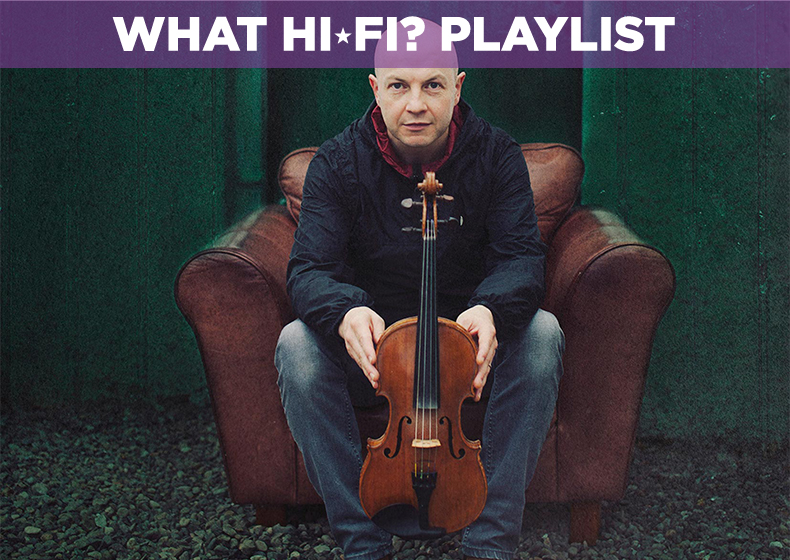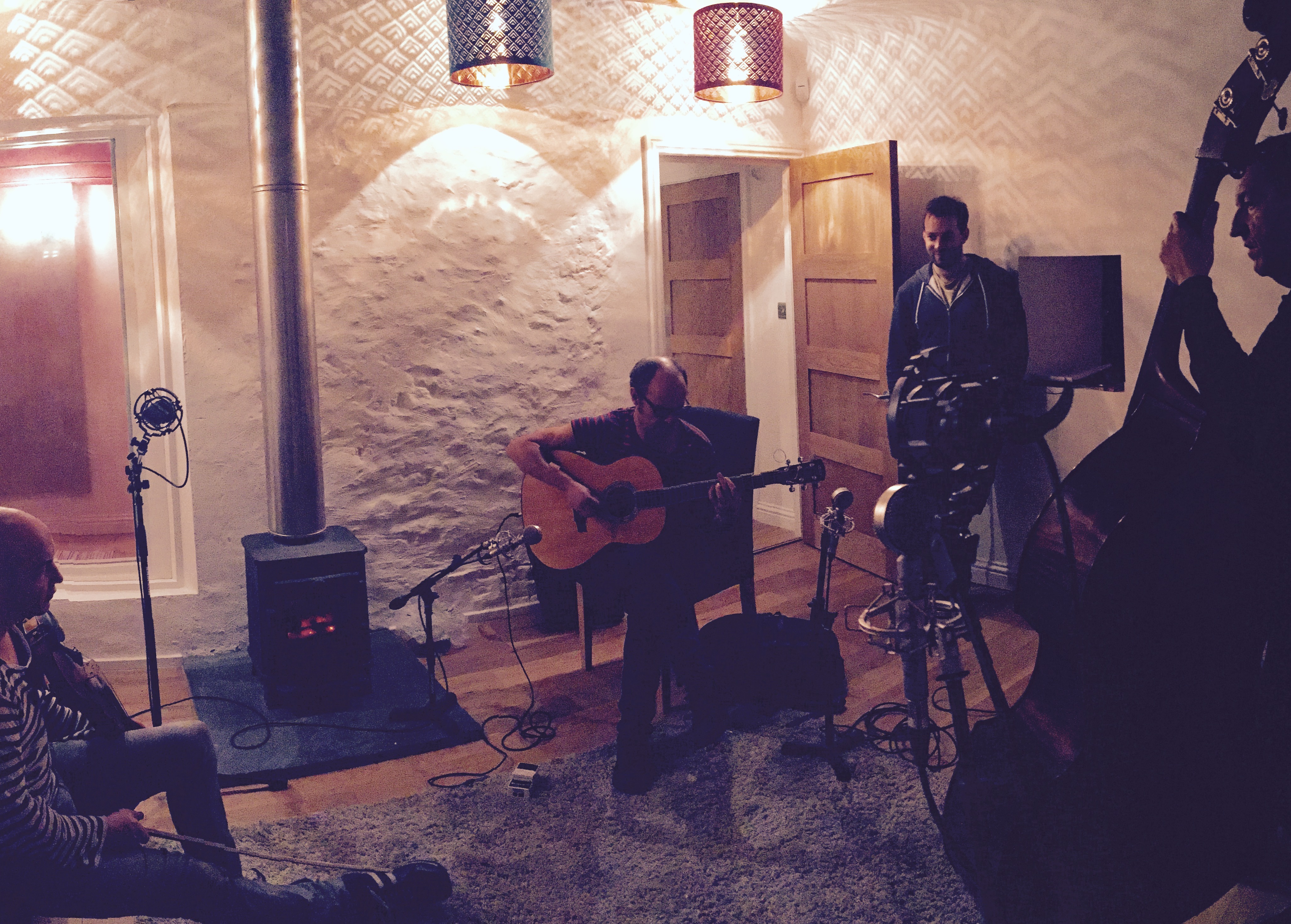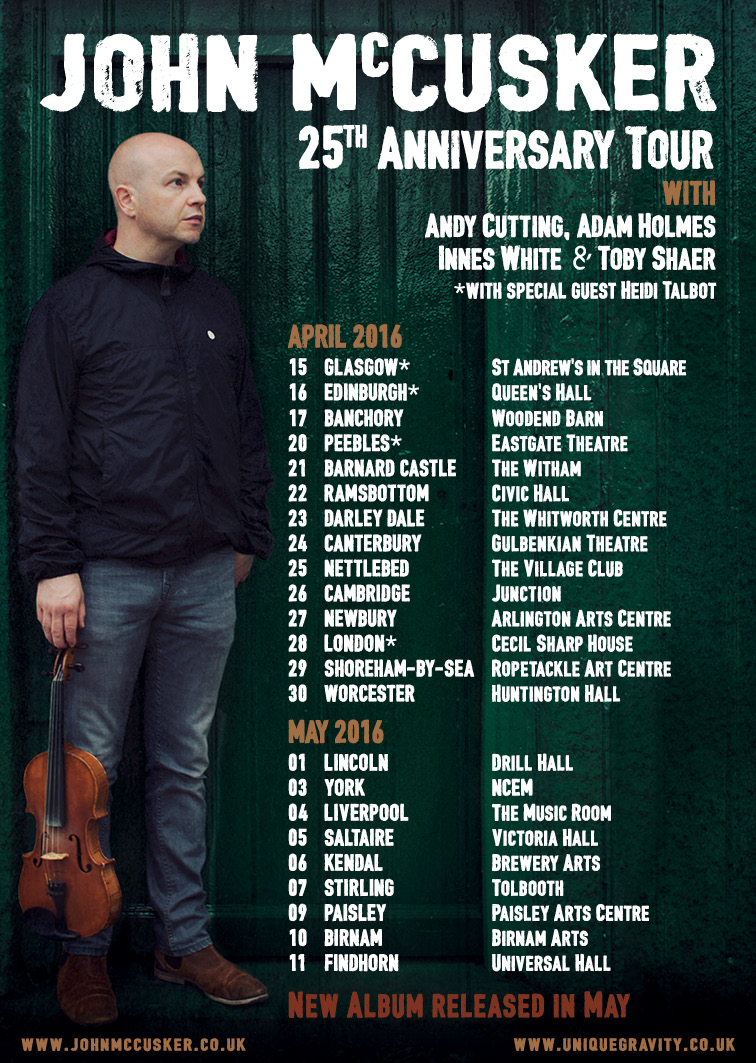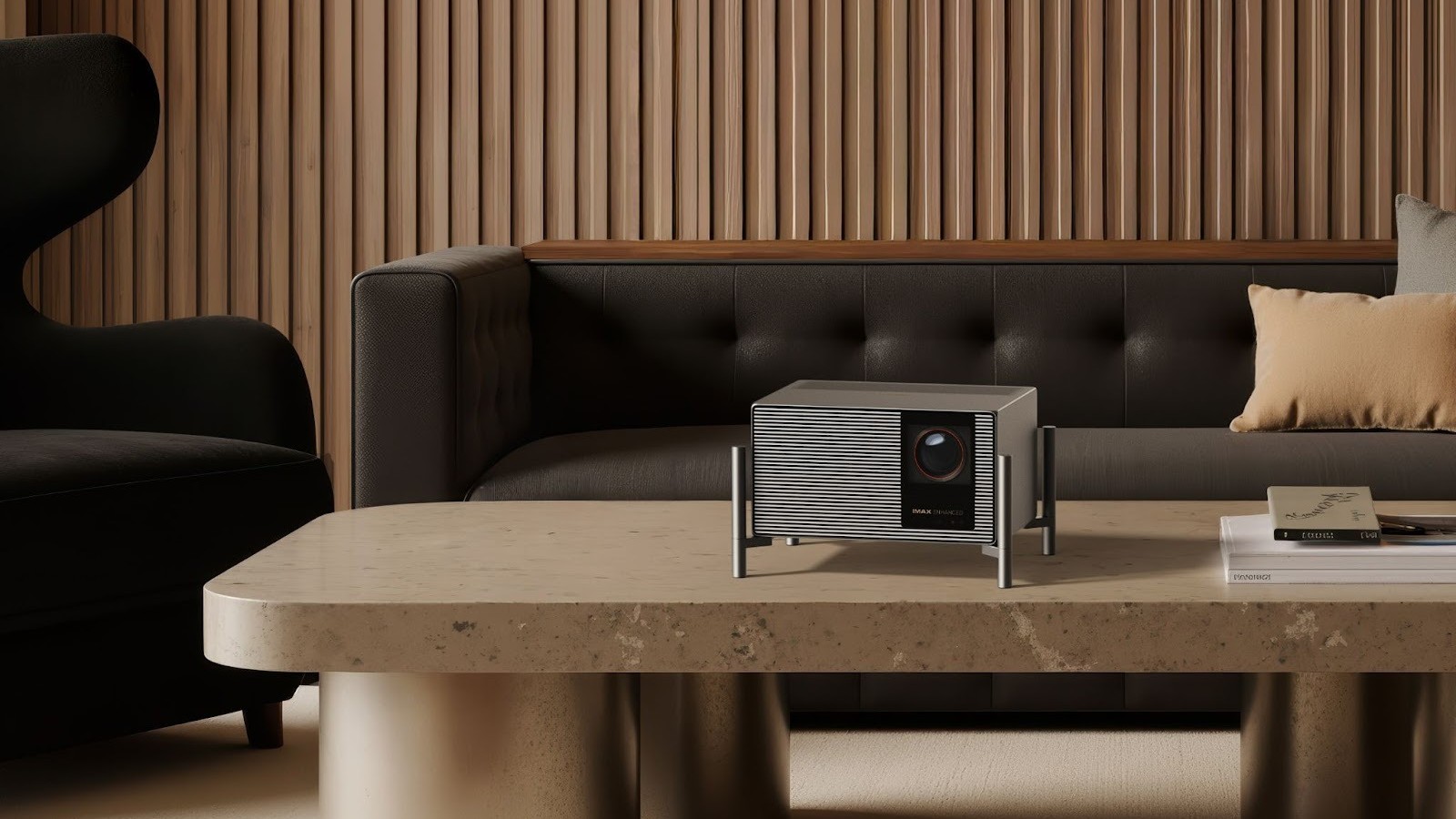Audio file: John McCusker, folk musician
Acclaimed musician John McCusker discusses building a studio, the value of a beautiful performance and being in Mark Knopfler's band.

“When I was 17 I joined my first band and I was jumping up and down like a monkey,” says John McCusker. “It was like having a chimpanzee who’d just picked up a fiddle for the first time, with bad trousers on, not thinking about the music. But over the years you get more experience, you go and see your heroes play and see they’re not jumping up and down and eating bananas. Hopefully you learn from people.”
After a quarter of a century as a professional musician, McCusker recently navigated the steepest learning curve of all when he built his own recording studio almost from scratch. That’s where the 2003 BBC Radio 2 Musician of the Year recorded and mixed his soon-to-be-released solo record, Hello, Goodbye, which he composed while playing as part of Mark Knopfler’s band on his latest world tour.
As well as Knopfler, whose band he joined eight years ago, and his solo work, McCusker has also shared stages with Paul Weller, Paolo Nutini, Teenage Fanclub, Graham Coxon and Eddi Reader. The core musical group playing on his latest record reads like an all-star cast of those with whom he has worked over the past 25 years, including bassist Ewen Vernal (Deacon Blue, Capercaille), whistle player Michael McGoldrick (Mark Knopfler, Capercaille), Grammy Award-winning bluegrass musician Tim O’Brien, and his wife, Irish singer Heidi Talbot.
Over the course of an hour, McCusker tells us how building a creative space grew into a state-of-the-art studio, how he attempts to coax the most beautiful performance out of his fellow musicians and what he loves about the records he returns to visit again and again.
Building the perfect studio

What Hi-Fi?: It seems appropriate to begin speaking about building your new studio; tell us about that process.
John McCusker: My wife Heidi and I both play music and we were looking for a house. We wanted an outbuilding of some kind we could turn into a studio; that was the main criteria for moving, really. And we found this place on the borders, built in 1779, and it’s got a thing called a bothy, which is a traditional place for somebody to shelter. In my head as soon as I saw it I thought, ‘This is the perfect space for a studio’.
So about two years ago we started the journey, and the idea was just for both of us to have a creative space – we didn’t think it’d grow arms and legs like it did. Once we started converting the coal shed into the control room, the hub, it just started: ‘Let’s block up that door, let’s knock through that big wall’. It grew to the point we were trying to create a state-of-the-art studio in a very old building. And it was exciting, but every time we knocked through a wall, we’d say, ‘Instead of that being a kitchen, why don’t we make it a vocal booth?’
The latest hi-fi, home cinema and tech news, reviews, buying advice and deals, direct to your inbox.
We had a studio designer, Calum Malcolm, who’s a friend and a legendary producer; he built and designed two of the biggest studios up here in Scotland, CastleSound in Pencaitland and the Gorbals Sound in Glasgow, and he’s produced a lot of people, everybody from the Krankies to the Blue Nile. But he’s a friend, so he was the perfect person. Him and his son Cameron, who is now an engineer, just looked at the space, and we spent two years, because it’s not a massive space, just trying to make the best possible use of that space.
We knocked through so many walls; the little space for the vocal booth, we said, ‘Well, we need a window, and if we’re going to have a big window there’re two-foot thick walls’. All the walls are two foot, so every time you knock through you’re slightly concerned that the whole building was going to fall down.
Once we’d done that creating the spaces, it was a job of trying to make it sound good, and they designed it sonically as well. It was an amazing journey; it was the very first time I’d ever had to build anything, let alone trying to create a studio out of a very old building.
WHF: Did you know from the off how you wanted it to sound?
JM: I’ve spent 25 years or more making records in studios from completely one end of the spectrum to the other, though I did take advice from Calum and from Mark Knopfler, who’s gone through the whole process with British Grove in London. I love the way Mark talks about his studio, which is the best of old and new.
Obviously our little place up here is on a much smaller scale, but I loved trying to create an environment where the booth sounded good, the live room was still lively enough but you had control over it, and in the control room to try and create a space where it was very realistic. That meant spending a lot of time with Calum getting the speakers up, getting the melamine foam in and using just the right amount of foam.
The first thing we bought, and the best advice I got from Mark and Calum, was to get some ATCs, realistic and great sounding speakers. That was the first purchase, and so we got our speakers up and started listening to our studio. So there were loads of processes and we just listened and we treated the room to the point where we started enjoying the sound. Anyone who’s got a studio knows they’re still a work in progress, but we’re really happy, we love having the space.
WHF: We’ve recently had not too dissimilar an experience, building new testing rooms and getting used to how they sound.
JM: What was most interesting for me, not having been through anything like this before, was the importance of filling every single tiny little gap so there was no leak. I didn’t really understand it until I’d got the studio. All the basic information was new to me; although I’ve produced records for years, I’ve never been on the other side of trying to create a studio. Like I say, it’s been much smaller scale, but I’ve spent a lot of time in London at British Grove, playing in Mark Knopfler’s band, and I now completely understand when he says he can’t wait to get in the studio in the morning. When you’ve got your own little creative space, it makes everything much more exciting.
A learning process
WHF: You mentioned the honesty of the ATCs; is transparency your main concern when choosing studio kit?
JM: I suppose. That’s another thing I’m learning about more now: what to listen to the mixes back on. I suppose what we wanted was that transparency of it sounding kind of what it’s going to sound like. The ATCs – we’ve got the SCM25s, so they’re not the massive ones but they’re perfect for the size of the control room – they’re the first pair of speakers that I absolutely love. We’ve got a small pair of NHTs as well, which are great. They don’t have the bottom end of the ATCs, but I quite like them because of that, for a completely different sound. But when I don’t have the ATCs, I really miss them; they’re by far the best speakers I’ve ever purchased or heard music on, to be honest.
WHF: What do you use in the house, then?
JM: I have the NHTs in the house. I bought them on tour. One of the lads in the band has a little flight case with NHTs for hotel rooms and they were great for having a party and playing music, they’re just brilliant speakers. He was taking a sub, because you do lose a lot of bottom end on them, but I absolutely love those speakers and I was using them with my hi-fi for a long time.
The nature of our house is that we’ve got music in every room; there are different ways of listening to music scattered around the place. I’ve got a NAD turntable, the C 556. I love it, and that made me want to start playing vinyl again. One of the best things I got recently was a Sonos wireless speaker, I got it last Christmas, and it’s so portable. I’ve got a Cambridge Audio amp and a Cambridge CD player I’ve had for a few years now, and I absolutely love that.
With the new record, I enjoyed listening to it on various different speakers and headphones. I was quite conscious, maybe for the first time, of the way other people might listen to music – not just listening to it through the ATCs or the NHTs or the speakers around the house, but actually listening to it on the laptop thinking, this is how lots of people are going to listen to this at home. It was interesting hearing how mixes sounded with all those instruments on different speakers and different systems.
WHF: What’s most important to you while mixing?
JM: What I’m trying not to do with the mixes is be disappointed when I hear it on a certain system, and that includes my Macbook or my phone. A good example is the first track off the record; just because I saw it when I was on Twitter, I listened to it on my phone. And there’s something great about that, that it sounds alright on the phone, that I enjoyed listening to it. Then I listen to it on my laptop, and on into the studio and plug my iPad in and listen to it on the ATCs.
In studios it’s great to have a little kind of speaker that might not be what you listen to music on. The more I make records, the more I mix to get some kind of balance across the board. It’s quite a step forward that I can listen to the new record and not want to throw the phone down the toilet. Having said that, I’m not going to spend lots of time listening to my new record around the house.
WHF: So when it’s done, it’s done?
JM: Yeah, it’s totally done. To be honest, it’s done very quickly after having made the record and I’m completely ready to move on to the next thing. Certain people throughout the course of my musical life say things, but Mark Knopfler told me, ‘It’s very difficult to make a good record’. And I completely know what that means. It can sound like just a simple remark, but I honestly think that the more records I make it’s like starting all over again.
Maybe the more records I make, I’m less concerned with making something sonically amazing; obviously that’s a massive part, but I am more concerned with the performance in the studio. If you get somebody to play beautifully, like they really mean it, then it makes everything sound better. If I’ve learned one thing over the years, it’s to try and capture the magic in the studio. Don’t try and make it perfect, just try and capture something magical in that place.
WHF: You steer clear of cutting and pasting lots of takes, then?
JM: Those days are over for me. Obviously, you still ‘comp’, but the days of sitting for weeks and comping the life out of a record are over. You don’t realise you’re doing it at the time, but you do when you listen back. A good friend of mine, Richard Bennett – he’s produced lots and lots of records over the years – I was talking to him about that. I’d really comped every spontaneous note out of the record, and all you’re trying to do in your head is make it perfect, but he said, ‘Like lots of things, you have to go through a process’.
There’s always something you could do better, but what you’re trying to get is the sound of you and your friends having a nice time playing music. Those are the records I always go back to, when it sounds like a bunch of people breathing the same air in the studio, sat round and really enjoying making music together.
Falling back in love with music

WHF: In that sense, how important is it to capture the space of a room?
JM: It’s really important. This record was the first one in a while where I’d spent quite a bit of time experimenting, because I had the luxury of the space. The live space in the studio, I really love it, but trying to have control over it is difficult. I’ve got his Coles microphone, it’s the best purchase I’ve ever made microphone-wise, and it captures as much of the room as it does of the instrument. So I really enjoyed that process, but over the years I’ve learned that it’s one of the most important things.
But whenever I play my favourite gigs, and I come off stage and say, ‘I really enjoyed that’, it’s because there’s a moment that happens on stage where people really connect musically; a magic happens where everyone’s buzzing off each other. But to try and recreate that in the studio, I think it goes back to what Mark said, that it’s very difficult to make a good record, to create that energy. But one of the ways you get closer to achieving it is by people looking at each other, being able to see the person you’re playing with and everybody playing at the same time. The one thing I think helps make a microphone or speakers sound great is a really confident or beautiful performance.
WHF: Which records fit that bill for you?
JM: Because I’ve got two young children, including a five-year-old, it's often stuff she wants to listen to. I spend a lot of time listening to children’s music, but when I listen to grown-up music it goes back to that thing when they’ve captured some magic in the studio. There’s a band called The Low Anthem, and you see pictures of them recording in a grand old warehouse and they’re round one microphone, and the whole place is lit with candles, and they’re just recording and trying to capture the beauty. You’re making records and you think you’re getting better at making records, and hopefully you are, but somebody will come along and make a record and you feel like you’re back to the drawing board again.
That’s a positive thing, feeling that way in general; it’s great to keep trying to improve and be inspired by other people. Jack White, from the White Stripes, is one of my biggest influences in terms of how he makes music, how he captures music sometimes very quickly, how he markets it, his passion for vinyl, for creating seven inches. An artist will go in and do an A and a B side in one day, everything live and cut to seven-inch, and then make beautiful videos and make it look great. It’s like going back to when you started buying records for the first time. It was one of the main motivations for starting mine and Heidi’s record label, Under One Sky Records; trying to make people fall in love with music all over again, I love that idea.
WHF: Who has made you up your level as a musician most?
JM: I joined Mark Knopfler’s band eight years ago and at the time I didn’t know what I was going to do with my life musically. I was moving back to Scotland from England and I got the call to go on tour with him, and I met all these legendary musicians who’d recorded with all these country stars and rock stars. My musical world just got loads bigger. That was really like going back to the drawing board of to learn how to play with Mark, or of playing the Hollywood Bowl or the Royal Albert Hall, how to really be yourself and fit into a band full of the most incredible musicians you’ve ever heard in your life. Without exaggerating, it’s the most inspiring thing that has ever happened to me.
McCusker's new album Hello, Goodbye is available to pre-order now.
MORE: Audio file: Rod Jones, Idlewild guitarist and producer
